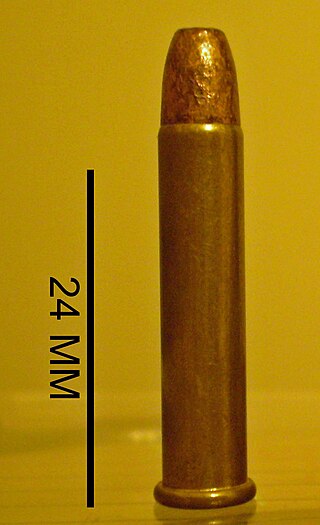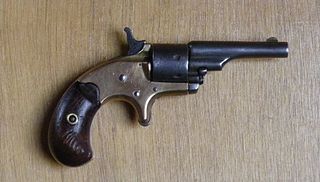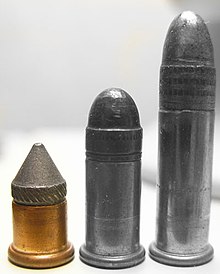
A firearm is any type of gun that uses an explosive charge and is designed to be readily carried and used by an individual. The term is legally defined further in different countries.

A cartridge, also known as a round, is a type of pre-assembled firearm ammunition packaging a projectile, a propellant substance and an ignition device (primer) within a metallic, paper, or plastic case that is precisely made to fit within the barrel chamber of a breechloading gun, for convenient transportation and handling during shooting. Although in popular usage the term "bullet" is often used to refer to a complete cartridge, the correct usage only refers to the projectile.

A derringer is a small handgun that is neither a revolver, semi-automatic pistol, nor machine pistol. It is not to be confused with mini-revolvers or pocket pistols, although some later derringers were manufactured with the pepperbox configuration. The modern derringer is often multi barreled, and is generally the smallest usable handgun of any given caliber and barrel length due to the lack of a moving action, which takes up more space behind the barrel. It is frequently used by women because it is easily concealable in a purse or a stocking.

A rim-fire is a type of metallic cartridge used in firearms where the primer is located within a hollow circumferential rim protruding from the base of its casing. When fired, the gun's firing pin will strike and crush the rim against the edge of the barrel breech, sparking the primer compound within the rim, and in turn ignite the propellant within the case. Invented in 1845 by Louis-Nicolas Flobert, the first rimfire metallic cartridge was the .22 BB Cap cartridge, which consisted of a percussion cap with a bullet attached to the top. While many other different cartridge priming methods have been tried since the early 19th century, such as teat-fire and pinfire, only small caliber rimfire cartridges have survived to the present day with regular use. The .22 Long Rifle rimfire cartridge, introduced in 1887, is by far the most common ammunition found in the world today in terms of units manufactured and sold.

A breechloader is a firearm in which the user loads the ammunition from the breech end of the barrel, as opposed to a muzzleloader, in which the user loads the ammunition from the (muzzle) end of the barrel.

The .22 Long Rifle, also known as the .22LR or 5.6×15mmR, is a long-established variety of .22 caliber rimfire ammunition originating from the United States. It is used in a wide range of firearms including rifles, pistols, revolvers, and submachine guns.

The .22 CB cap (Conical Bullet Cap), also known as the 6mm Flobert, is a more powerful version of the .22 BB cap rimfire metallic cartridge, which was invented by Louis-Nicolas Flobert in 1845. The .22 BB cap and .22 CB cap are interchangeable and are relatively quiet, low velocity cartridges, designed for indoor target shooting.

.22 Short is a variety of .22 caliber (5.6 mm) rimfire ammunition. Developed in 1857 for the first Smith & Wesson revolver, the .22 rimfire was the first American metallic cartridge. The original loading was a 29 or 30 gr bullet and 4 gr of black powder. The original .22 rimfire cartridge was renamed .22 Short with the introduction of the .22 Long in 1871.

The .22 Long is a variety of .22 caliber (5.6 mm) rimfire ammunition. The .22 Long is the second-oldest of the surviving rimfire cartridges, dating back to 1871, when it was loaded with a 29 gr (1.9 g) bullet and 5 gr (0.32 g) of black powder, 25% more than the .22 Short on which it was based. It was designed for use in revolvers, but was soon chambered in rifles as well, in which it gained a reputation as a small game cartridge.

The .32 S&W cartridge was introduced in 1878 for Smith & Wesson pocket revolvers. It was originally designed as a black powder cartridge. The .32 S&W was offered to the public as a light defense cartridge for "card table" distances.

The .22 Winchester Magnum Rimfire, also known as the .22 WMR, .22 Magnum, .22 WMRF, .22 MRF, or .22 Mag, is a rimfire cartridge. Originally loaded with a bullet weight of 40 grains (2.6 g) delivering velocities in the 2,000 feet per second (610 m/s) range from a rifle barrel, .22 WMR is now loaded with bullet weights ranging from 50 grains (3.2 g) at 1,530 feet per second (470 m/s) to 30 grains (1.9 g) at 2,200 feet per second (670 m/s).

The 6mm PPC, or 6 PPC as it is more often called, is a centerfire rifle cartridge used almost exclusively for benchrest shooting. It is one of the most accurate cartridges available at distances of up to 300 meters. This cartridge's accuracy is produced by a combination of its stout posture, being only 31 mm (1.22 in) long, and aggressive shoulder angle of 30 degrees. Its primary use has been benchrest shooting matches since the 1980s.

An antique firearm is a term used to describe a firearm that was designed and manufactured prior to the beginning of the 20th century. Although the exact definition of what constitutes an "antique firearm" varies between countries, the advent of smokeless powder or the start of the Boer War are often used as cut-off dates. Antique firearms are usually collected because of their historical interest and/or their monetary value.

A handgun is a firearm designed to be usable with only one hand. It is distinguished from a long gun which needs to be held by both hands and braced against the shoulder. Handguns have shorter effective ranges compared to long guns, and are much harder to shoot accurately. While most early handguns are single-shot pistols, the two most common types of handguns used in modern times are revolvers and semi-automatic pistols, although other handguns such as derringers and machine pistols also see infrequent usage.

.22 caliber, or 5.6 mm, refers to a common firearms bore diameter of 0.22 inch (5.6 mm) in both rimfire and centerfire cartridges.

The 5 mm Remington Rimfire Magnum or 5 mm RFM is a bottlenecked rimfire cartridge introduced by Remington Arms Company in 1969. Remington chambered it in a pair of bolt-action rifles, the Model 591 and Model 592, but this ammunition never became very popular, and the rifles were discontinued in 1974. About 52,000 rifles and 30,000 barrels for the T/C Contender pistol were sold during its brief production run. Remington discontinued the cartridge itself in 1982, leaving owners with no source of ammunition.
A gallery gun, Flobert gun, parlor gun or saloon gun is a type of firearm designed for recreational indoor target shooting. These guns were developed in 1845, when French inventor Louis-Nicolas Flobert created the first rimfire metallic cartridge by modifying a percussion cap to hold a small lead bullet. In the 19th century, gallery guns were typically pump-action rifles chambered in .22 Short. Gallery guns are still manufactured, although by the late 20th century, they have been eclipsed by airguns for the purpose of indoor shooting.

The Colt Open Top Pocket Model Revolver was a single action pocket revolver introduced by the Colt's Patent Fire Arms Manufacturing Company in 1871. Introduced a year before the Colt Open Top and two years before the Colt Peacemaker and the Colt New Line, the Colt Open Top Pocket Model Revolver was, alongside the Colt House Revolver, one of the two first metallic cartridge rear-loading revolvers manufactured by Colt's. It also was one of the first pocket metallic cartridge revolvers made by the company.

Louis-Nicolas Flobert (1819–1894) was a French inventor. He invented the first metallic rimfire cartridge in 1845. It was a major innovation in firearms ammunition technology, as it was previously delivered as separate bullets and gunpowder, pertaining to muzzle-loading firearms. The rimfire cartridge combined both elements in a single metallic cartridge containing a percussion cap, gunpowder, and a bullet, into a single weatherproofed package or container. Before that, a "cartridge" was simply a pre-measured quantity of gunpowder together with a ball (bullet), in a small cloth bag, which also acted as wadding for the powder charge and ball.


















